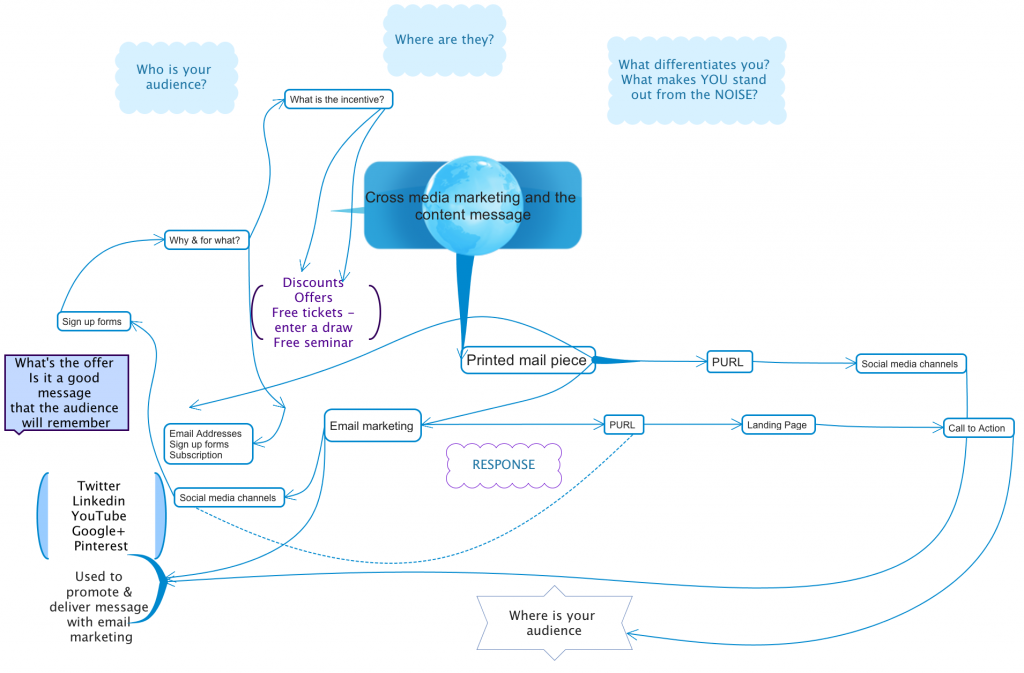So far I’ve sang from the tree tops about the merits of good content, why personalisation is so important and how print fits into the cross media marketing mix.
But what I haven’t shared with you is how do you make sure your content is read?
I should make one thing absolutely clear, this is not a lesson in how to write great content for the internet, this is about how you get your marketing message to stand out from the crowd.
Cross media marketing combines highly personalised targeted messages across the various types of media to seek interaction and engagement with your niche audience.
Cross media marketing is a specific, targeted and measurable marketing strategy designed to deliver consistent, persuasive and actionable messages to your target customers using a variety of social channels over a period of time that engage and reinforce your company and brand.
But it is becoming increasingly difficult to be heard by your prospect let alone engage when the sheer volume of noise from the various social channels is densely populated with mass messages.
Businesses are further hindered by the number of social media channels to use, which one, or combination of platforms are likely to give the best yield of leads or conversions.
Smaller budgets in the current economic climate with which to carry out marketing are limited.
A successful content marketing campaign combining cross media marketing that delivers content and a call to action throughout the channels simultaneously as an integrated campaign.
Brand awareness is 44% print and 37% online media therefore the importance of your brand consistency is essential and it’s not just about making sure the logo is the same across all media.
What do I need to do?

Cross media marketing what is it and where does it fit in with social media and print?
1. Ensure your brand is coherent across all platforms including print, website, social media. Does it convey your message, your brand and does it represent what the company, service, product stand for?
By developing a consistent brand that delivers meaningful communication your brand effectively demonstrates a strong, authoritative company that knows what they are talking about and in turn this generates trust in your business.
Branding also gives you and your company an identity and personality so that your audience become familiar with you and what you do.
Ensuring you order marketing collateral from the same supplier will guarantee consistency of your brand in the way it looks, the feel and the overall quality.
Cross media marketing focusses on the audience and not the product or service, it is customer-centric and not product-centric therefore delivery of any content or message has to start with a deep understanding of your customer’s objectives and background.
2. Successful marketing messages start with a plan. By developing a well co-ordinated message, ensuring your customer database is accurate and up to date with names and addresses is key to developing the strategy and the content that will unveil itself across all the social media channels.

A cross media campaign needs to start with a plan. Who is it for, what does the message convey? What is our goal?
3. Use the information you’ve captured about your prospect, you need to understand your audience and be able to identify which platforms they engage on the most. There’s no point sending SMS or using social media if your audience is 75+ and is more likely to be responsive to a direct mail piece. In the same way delivering a message via social media to an audience who are between 18-25 years is likely to be highly effective but it depends on the message and what you are targeting.
It would be like me sending a mass message about auto-enrolment and payroll to debt collection managers, wrong audience, wrong message.
4. Understanding your audience is paramount in developing engagement. Once that’s been done then personalising the content that takes into account all the information will make the prospect more compelled to read.
Each media platform delivers content differently therefore generating a different response. Printed media provides a physical piece of advertising that the customer can read and physically engage with if this is incorporated with an email campaign it creates a better response rate than email marketing on its own.
Knowing your audience can then guide you as to the type of message you want to deliver and what the call to action will be. As I said earlier consistency and continuity are key, use the same colours, logos, images so subliminally the audience start to associate the colours, or the look with your brand. It does work otherwise marketers wouldn’t do it, the constant reinforcing of the message ensures your audience remembers that message and when the time is right it invokes in us the desire to buy from that brand or company.
Personalising the content on the direct mail piece with a PURL moves the customer to a landing page that is completely relevant to him, by asking him for more information thus making future messages more targeted to suit him.
5. Send a follow up email using the information they supplied on the landing page and provide an offer or incentive to jump to the next stage.
6. Send an automated follow up email to those that haven’t responded to either the direct mail or your email making sure there is a PURL to encourage them to go to their personalised landing page.
7. In each of the steps integrate your social share buttons – facebook, Pinterest, twitter and include it on the printed mail piece, showing how and where your company or brand can be found.
8. Finally don’t forget to measure it. Look at your response rates, open rates on email and compile a simple spreadsheet so you can see who viewed what message and on what platform.
9. Start with a two channel campaign such as a printed direct mail piece with a PURL directing them to a landing page and link to facebook then add a third channel and so forth.
10. Remember the key is knowing your audience and making sure you deliver the right content there is no point in sending an email message to a 45 year old mother of 4 directing her to a 2 seater sports car landing page. She may well desire that very car but she’s practical and needs a vehicle that can carry 4 kids therefore the email message is unlikely to light her fire.
11. What makes content and cross media campaigns so useful is the way in which they can interact with each other thus increasing the likelihood of engagement = leads = customers.
Your message should drive your niche audience to do one action only – visit a landing page, register for an event, follow on a social media channel. Give them or ask them to do too much and they lose interest and the lead is lost along with the potential for engagement.
A successful message is designed to promote your brand, develop customer relationships, show your company’s authority, subliminally seduce your audience in to remembering you so when they are ready to buy they come to ‘you’.




Good article, thanks Caroline. I thought the piece about measurement was especially good, it’s one that lots of people don’t do. Measuring what you do and the results you get is very important.
At the other end of the spectrum your reminder about having a simple spreadsheet made me smile. Some people measure in such complexity that they couldn’t do anything with the results of their analysis, even if they tried!